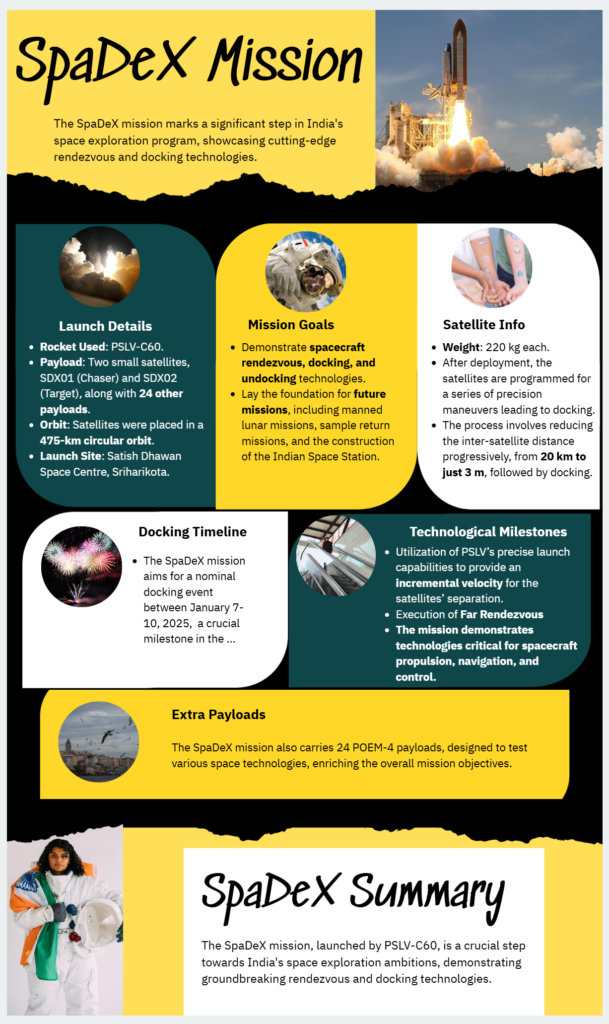Source: The Hindu (SpaDex)
Why in News?
On December 30, 2024, the Indian Space Research Organisation (ISRO) successfully launched the Space Docking Experiment (SpaDeX) mission, marking a significant milestone in the advancement of space technology. This mission is a step forward in demonstrating India’s capability in spacecraft rendezvous, docking, and undocking—a technology mastered by only a select few spacefaring nations.
Key Highlights of the SpaDeX Mission

- Launch Details:
- Rocket Used: PSLV-C60.
- Payload: Two small satellites, SDX01 (Chaser) and SDX02 (Target), along with 24 other payloads.
- Orbit: Satellites were placed in a 475-km circular orbit.
- Launch Site: Satish Dhawan Space Centre, Sriharikota.
- Mission Objectives:
- Demonstrate spacecraft rendezvous, docking, and undocking technologies.
- Lay the foundation for future missions, including manned lunar missions, sample return missions, and the construction of the Indian Space Station.
- SpaDeX Satellite Details:
- Weight: 220 kg each.
- After deployment, the satellites are programmed for a series of precision maneuvers leading to docking.
- The process involves reducing the inter-satellite distance progressively, from 20 km to just 3 m, followed by docking.
- Timeline:
- Nominal docking time expected between January 7-10, 2025.
- Technological Milestones:
- Utilization of PSLV’s precise launch capabilities to provide an incremental velocity for the satellites’ separation.
- Execution of Far Rendezvous: Satellites achieving identical orbits with a separation of 20 km, followed by precise maneuvering for docking.
- The mission demonstrates technologies critical for spacecraft propulsion, navigation, and control.
- Additional Payloads:
- 24 PS4-Orbital Experiment Module (POEM-4) payloads were also onboard, designed to test various space technologies.
Significance of SpaDeX Mission
| Aspect | Details |
|---|---|
| Technological Edge | Mastery in docking technology enables futuristic missions, including crewed lunar landings and space station operations. |
| Global Recognition | Places India among an elite group of nations with this advanced capability. |
| Future Missions | Critical for India’s ambitions in establishing its own space station and conducting Moon sample return missions. |
| Cost Efficiency | Demonstrates ISRO’s capability to achieve advanced missions at a fraction of the cost of other nations. |
| Scientific Experiments | POEM-4 payloads onboard the mission will contribute to research and technology validation. |
Way Forward
- Enhanced Space Exploration:
- Leverage SpaDeX technologies for lunar missions and interplanetary exploration.
- Support India’s Gaganyaan mission and future crewed missions to the Moon.
- Space Station Development:
- Use docking technologies to design and operate the proposed Indian Space Station, fostering long-term human presence in space.
- Collaboration:
- Strengthen partnerships with other nations for joint missions and sharing of advanced space technology.
- Private Sector Involvement:
- Encourage private companies to participate in the development of docking technologies and payloads.
The SpaDeX mission is a giant leap for ISRO and India’s space program, as it establishes a strong technological foundation for advanced space exploration. It also reaffirms India’s position as a rising global leader in space technology.


